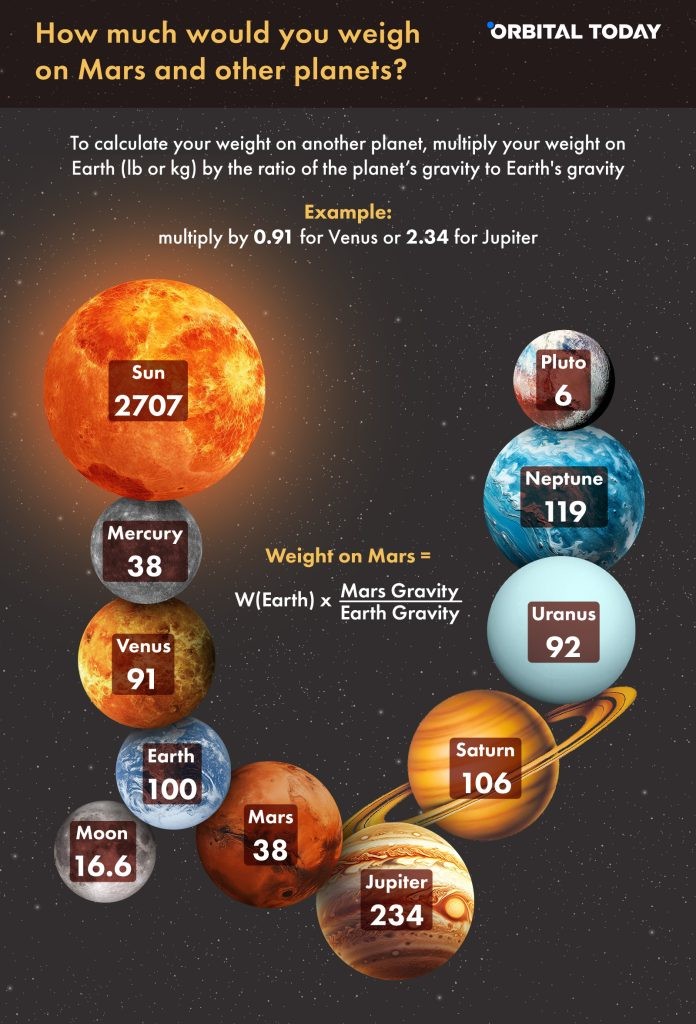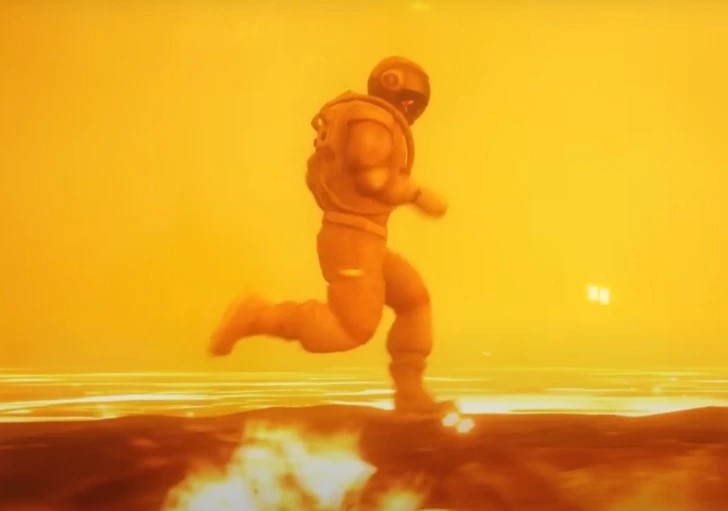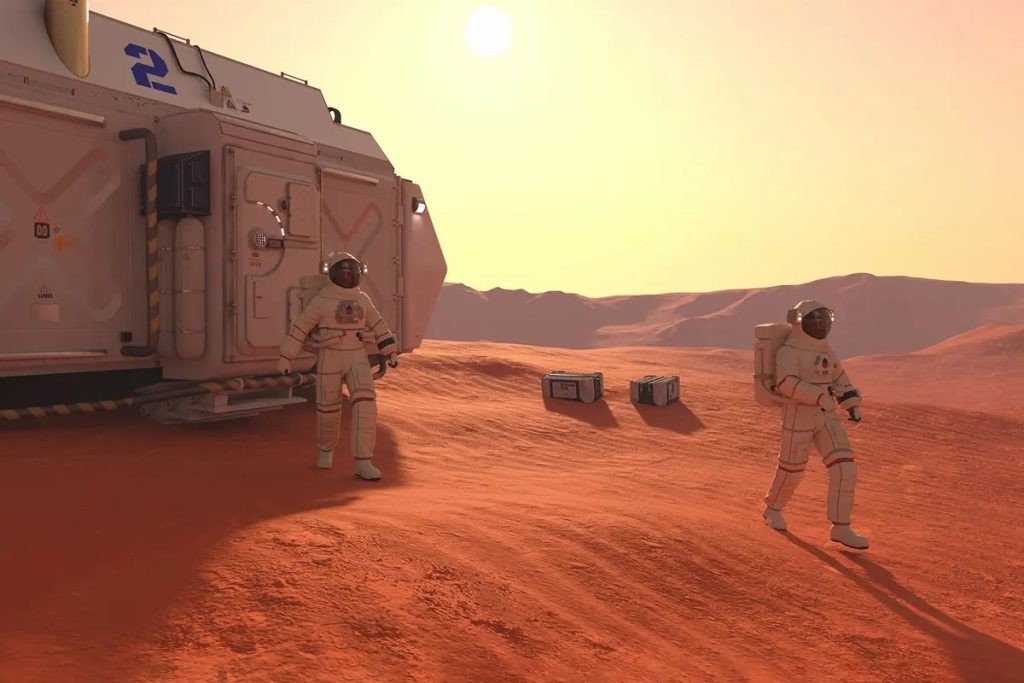How Strong Is Mars Gravity Compared To Earth? Mars gravity is about 38% as strong as Earth’s. At COMPARE.EDU.VN, we delve into the comparison of gravitational forces between Mars and Earth, providing you with a comprehensive understanding. Understanding the difference is crucial for future Mars missions, influencing everything from astronaut health to spacecraft design, explore gravitational differences, long-term health effects and planetary exploration facts, this comparison unveils the key differences between Martian and terrestrial gravity.
Table of Contents
1. What is Gravity?
Gravity, derived from the Latin word “gravis” meaning “heavy,” is the fundamental force of attraction between objects with mass. This universal interaction dictates that any object with mass exerts a gravitational pull proportional to its mass and inversely proportional to the square of the distance. Consequently, larger and closer objects exert a stronger gravitational force.
Earth, being the most massive object in our vicinity, exerts a significant gravitational pull on all nearby bodies. This force, commonly known as gravity, causes objects like apples to fall towards the ground rather than floating away. The force of gravity is quantified by the formula F = m ⋅ g, where ‘m’ represents the mass of the body and ‘g’ is the gravitational acceleration. Gravitational acceleration is the uniform acceleration experienced by objects in a vacuum due to gravity near the surface, regardless of their mass.
The acceleration due to gravity on Earth’s surface is approximately 9.8 m/s², a constant value. This implies that an object in free fall experiences a speed increase of 9.8 m/s every second. Conversely, an object moving vertically upwards experiences a speed decrease of 9.8 m/s each second. This acceleration experienced on the surface of a celestial body is also termed surface gravity. Now, let’s explore the surface gravity of Mars in comparison to Earth and other celestial bodies.
2. How Does Gravity on Mars Compare to Earth, Moon and Venus?
When Earth’s surface gravity is considered at 100%, Venus has a surface gravity of 91%, the Moon has 16.6%, and Mars has 38%. For instance, if you weigh 200 pounds on Earth, you would weigh 182 pounds on Venus, 76 pounds on Mars, and only 38 pounds on the Moon. It is worth recalling the ease with which the Apollo astronauts moved on the Moon, despite their spacesuits weighing 130 pounds.
To provide a clearer comparison, here’s a table summarizing the surface gravity of these celestial bodies relative to Earth:
| Celestial Body | Surface Gravity (Relative to Earth) | Approximate Weight (if you weigh 200 lbs on Earth) |
|---|---|---|
| Earth | 100% | 200 lbs |
| Venus | 91% | 182 lbs |
| Moon | 16.6% | 33.2 lbs |
| Mars | 38% | 76 lbs |



This difference in gravity significantly impacts various aspects of space exploration, including the design of equipment and the physical effects on astronauts. The reduced gravity on Mars, while lower than Earth’s, still presents unique challenges and opportunities for future colonization and scientific research. Understanding these gravitational differences is crucial for planning and executing successful missions to the Red Planet.
2.1 Why Is Mars’ Gravity So Low?
The gravitational force on planets and moons is determined by their mass and the inverse square of their radius. A greater mass and a smaller radius result in a stronger gravitational force, and vice versa. Given that astronomical objects vary in mass and radius, their corresponding ‘g’ values also differ.
Mars has a mass approximately 0.107 times that of Earth, or about 1.523 x 10^23 pounds. The radius of Mars is 2,106 miles, nearly half the radius of Earth, which is 3,959 miles. These factors contribute to Mars having a significantly lower surface gravity than Earth.
The relationship between mass, radius, and gravity can be expressed as:
g = (G * M) / r²
Where:
- g = surface gravity
- G = gravitational constant (approximately 6.674 × 10^-11 N⋅m²/kg²)
- M = mass of the celestial body
- r = radius of the celestial body
Using this formula, we can see how differences in mass and radius directly impact the surface gravity of a planet. Mars’ smaller mass and radius, compared to Earth, result in its lower gravity. This understanding is fundamental for designing equipment, planning astronaut activities, and predicting environmental conditions on Mars.
2.2 Would You Fall Faster on Mars?
Given that the acceleration of gravity on Mars is nearly three times less than on Earth, it might be intuitive to assume that objects would fall more slowly on the Red Planet due to a weaker gravitational pull. However, it’s essential to consider that the acceleration of gravity is calculated for bodies in a vacuum, and does not account for the height of the fall or air resistance. The Martian atmosphere has a density of only 20 grams per cubic meter, which is 61 times less dense than Earth’s atmosphere (1.225 kilograms per cubic meter). Consequently, the atmospheric resistance on Mars is so minimal that the final fall speed would be over five times higher than on Earth. Therefore, future colonists will need to carefully design spacecraft to ensure they do not crash upon landing.
To illustrate this point, consider the following comparison:
| Factor | Earth | Mars |
|---|---|---|
| Acceleration due to Gravity | 9.8 m/s² | ~3.71 m/s² |
| Atmospheric Density | 1.225 kg/m³ | ~0.020 kg/m³ |
| Relative Fall Speed | 1x | >5x |
This significant difference in atmospheric density plays a crucial role in determining the speed of falling objects. While the gravitational force is weaker on Mars, the reduced air resistance allows objects to accelerate to higher speeds, making landing and other activities potentially hazardous.
2.3 Is There Enough Gravity on Mars to Walk?
Yes, there is enough gravity on Mars to walk. Although you would weigh almost three times less on Mars compared to Earth, the weight of spacesuits will compensate for this difference. Neil Armstrong and Buzz Aldrin walked on the Moon with relative ease, even though the Moon has even less gravity than Mars. In general, there is no need to be afraid; you will be able to maintain your footing on the surface of the Red Planet. The primary concern will be paying attention to where you step.
The feasibility of walking on Mars is supported by the following considerations:
- Spacesuit Weight: Spacesuits are designed to provide life support and protection, adding substantial weight that approximates terrestrial conditions.
- Lunar Experience: The Apollo missions demonstrated that humans could walk and perform tasks effectively on the Moon, which has even lower gravity than Mars.
- Adaptation: Human physiology can adapt to varying gravitational conditions over time, reducing the initial challenges of mobility.
Therefore, despite the lower gravity, walking on Mars is not only possible but also manageable with the appropriate equipment and adaptations.
2.4 Could I Run Faster on Mars?
In theory, yes, but several other factors must be considered. On Earth, marathon speed averages 6 miles per hour, while professional runners can reach speeds of up to 27 miles per hour. Considering the difference in gravity between Mars and Earth, these speeds could be multiplied by a factor of 2.7. However, running on Mars requires a heavy spacesuit and boots to protect against the harsh Martian atmosphere and landscape.
Upon stepping onto the surface of the Red Planet, you would encounter rust-colored dust. The thickness of this dust layer varies across different locations but averages around two meters. This fine dust also floats in the air, sometimes creating dust storms, some of which are visible from Earth. These conditions could make running considerably more challenging.
The potential to run faster on Mars is influenced by:
- Reduced Gravity: Lower gravity allows for longer strides and reduced impact forces.
- Atmospheric Conditions: The thin atmosphere provides less resistance, potentially aiding in higher speeds.
- Spacesuit Limitations: Heavy, bulky spacesuits can restrict movement and reduce overall agility.
- Surface Conditions: The presence of fine dust and uneven terrain can impede running and increase the risk of falls.
2.5 Is Mars Gravity Survivable?
Assuming a safe landing and the ability to walk on the surface of the Red Planet, the question remains: Can you survive on Mars in low gravity? While it won’t cause immediate death, it can have long-term health effects such as bone loss, muscle atrophy, cardiovascular problems, vision impairment, and swelling. Astronauts experience many of these issues after extended stays on the International Space Station (ISS), where gravity is only 12% lower than Earth’s.
Surviving on Mars requires significant effort. Astronauts will need to exercise regularly and take additional measures to maintain their physical health. Technicians and engineers will need to develop specialized spacesuits that minimize the effects of Mars gravity on humans. They must also create residential complexes with life support systems that replicate terrestrial living conditions as closely as possible.
The primary challenges to survival on Mars due to low gravity include:
- Bone Density Loss: Reduced gravity leads to decreased bone density, increasing the risk of fractures and osteoporosis.
- Muscle Atrophy: Muscles weaken and shrink due to reduced load-bearing, affecting strength and endurance.
- Cardiovascular Issues: The cardiovascular system adapts to lower gravity, potentially causing problems upon return to Earth.
- Vision Problems: Changes in fluid distribution can affect eye structure and function, leading to vision impairment.
Addressing these challenges through exercise, specialized equipment, and life support systems is crucial for the long-term survival and well-being of Mars colonists.
3. Conclusion
In summary, Mars’ gravity is lower than Earth’s, but it is sufficient for humans to survive and perform basic activities. However, it is essential to consider the nuances of living in such an environment. Studying the effects of low gravity on human health and capabilities is a critical objective for future missions to Mars and the establishment of long-term settlements on the planet.
Understanding the differences in gravity between Earth and Mars is vital for planning successful missions and ensuring the health and safety of astronauts. Key considerations include the design of spacesuits, the development of exercise regimens, and the creation of life support systems that mitigate the adverse effects of low gravity. By addressing these challenges, we can pave the way for sustainable human presence on Mars.
For further comparisons and detailed information, visit COMPARE.EDU.VN, where we provide comprehensive analyses to help you make informed decisions. Whether you’re planning a mission to Mars or simply curious about the differences between planets, COMPARE.EDU.VN offers the resources you need to explore and understand the complexities of space exploration.
4. FAQ
Q1: How does Mars gravity compare to Earth gravity?
Mars gravity is approximately 38% of Earth’s gravity. This means that if you weigh 100 pounds on Earth, you would weigh about 38 pounds on Mars.
Q2: Why is Mars gravity weaker than Earth’s?
Mars has less mass and a smaller radius than Earth, resulting in a weaker gravitational pull. The mass of Mars is about 0.107 times that of Earth, and its radius is roughly half that of Earth.
Q3: Would I fall slower or faster on Mars?
While the gravitational force is weaker on Mars, the atmospheric density is much lower. This reduced air resistance means you would actually fall faster on Mars compared to Earth.
Q4: Is there enough gravity on Mars to walk normally?
Yes, there is enough gravity on Mars to walk, but it would feel different. The lower gravity would make you feel lighter, and you would be able to jump higher and farther. Spacesuits also add weight, helping to compensate for the reduced gravity.
Q5: What are the long-term health effects of living in Mars gravity?
Long-term exposure to Mars gravity can lead to bone loss, muscle atrophy, cardiovascular problems, vision issues, and swelling. Astronauts need to exercise regularly and take measures to maintain their health in low gravity environments.
Q6: How do spacesuits compensate for the effects of Mars gravity?
Spacesuits add weight and provide resistance, which helps to simulate the effects of Earth’s gravity. They also offer protection from the harsh Martian environment, including radiation and extreme temperatures.
Q7: Could I run faster on Mars than on Earth?
In theory, yes. The lower gravity and thinner atmosphere could allow you to run faster. However, the added weight and bulk of a spacesuit would likely limit your speed.
Q8: How does Mars gravity affect spacecraft landing on the planet?
The lower gravity means that spacecraft need to use different landing techniques than they would on Earth. The thin atmosphere also affects the use of parachutes and other deceleration methods.
Q9: What kind of research is being done to understand the effects of Mars gravity on humans?
Researchers are conducting studies on astronauts in space, using bed rest studies on Earth, and developing computer models to simulate the effects of Mars gravity on the human body.
Q10: Where can I find more comparisons and information about Mars and Earth?
Visit COMPARE.EDU.VN for detailed analyses and comparisons to help you make informed decisions. We offer comprehensive resources to explore and understand the complexities of space exploration.
Ready to explore more comparisons and make informed decisions? Visit COMPARE.EDU.VN today. Our comprehensive analyses provide you with the resources you need to understand complex topics and make the best choices. Explore, compare, and decide with confidence!
Contact us at:
Address: 333 Comparison Plaza, Choice City, CA 90210, United States
Whatsapp: +1 (626) 555-9090
Website: compare.edu.vn